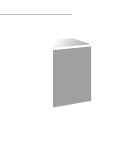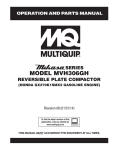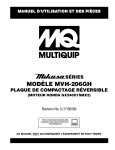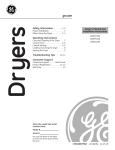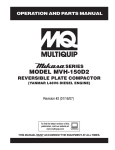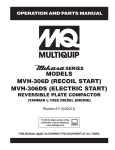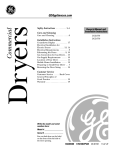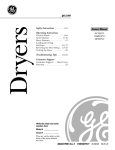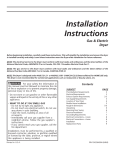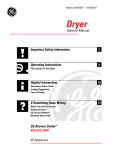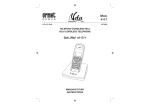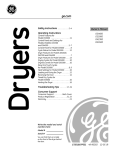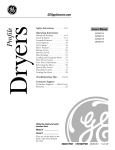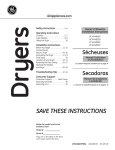Download GE DBI.333 User's Manual
Transcript
Dryers GEAppliances.com Safety Instructions . . . . . . . . . 2–5 Operating Instructions Control Panels . . . . . . . . . . . . . . . .6 Control Settings . . . . . . . . . . . . . . .7 Loading and Using the Dryer . . .8, 9 Owner’s Manual and Installation Instructions DBL333 DCL333 DVL223 Installation Instructions Electrical Requirements . . . . . . . 11 Exhausting the Dryer . . . . . . . . . 12 Installing the Dryer . . . . . . . . 13–19 Preparing to Install the Dryer . . 10 Troubleshooting Tips . . . . . 20, 21 Consumer Support Consumer Support . . . . Back Cover Warranty . . . . . . . . . . . . . . . . . . . 23 Write the model and serial numbers here: Model # __________________ Serial # __________________ You can find them on the label on the front of the left side of the door opening. 134098700 175D1807P367 49-90105 08-01 JR Safety Instructions IMPORTANT SAFETY INFORMATION. READ ALL INSTRUCTIONS BEFORE USING. WARNING! For your safety, the information in this manual must be followed to minimize the risk of fire or explosion, electric shock, or to prevent property damage, personal injury, or death. ■ Do not store or use gasoline or other Operating Instructions flammable vapors and liquids in the vicinity of this or any other appliance. ■ Installation and service must be performed by a qualified installer, service agency or the gas supplier. WHAT TO DO IF YOU SMELL GAS: not try to light a match, or cigarette, or 1 Do turn on any gas or electrical appliance. not touch any electrical switch; 2 Do do not use any phone in your building. Installation Instructions the room, building or area of all 3 Clear occupants. call your gas supplier from 4 Immediately a neighbor’s phone. Follow the gas supplier’s instructions carefully. you cannot reach your gas supplier, 5 Ifcall the fire department. California Safe Drinking Water and Toxic Enforcement Act This act requires the governor of California to publish a list of substances known to the state to cause cancer, birth defects or other reproductive harm and requires businesses to warn customers of potential exposure to such substances. Gas appliances can cause minor exposure to four of these substances, namely benzene, carbon monoxide, formaldehyde and soot, caused primarily by the incomplete combustion of natural gas or LP fuels. Consumer Support Troubleshooting Tips Properly adjusted dryers will minimize incomplete combustion. Exposure to these substances can be minimized further by properly venting the dryer to the outdoors. 2 WARNING! PROPER INSTALLATION This dryer must be properly installed and located in accordance with the Installation Instructions before it is used. ■ Install or store where it will not be exposed to temperatures below freezing or exposed to the weather. ■ Connect to a properly rated, protected and sized power supply circuit to avoid electrical overload. ■ Remove all sharp packing items and dispose of all shipping materials properly. Exhaust/Ducting: 1 This dryer MUST be exhausted to the outside. only rigid metal or flexible metal 4″ 2 Use diameter ductwork inside the dryer cabinet or for exhausting to the outside. USE OF PLASTIC OR OTHER COMBUSTIBLE DUCTWORK CAN CAUSE A FIRE. PUNCTURED DUCTWORK CAN CAUSE A FIRE IF IT COLLAPSES OR BECOMES OTHERWISE RESTRICTED IN USE OR DURING INSTALLATION. Follow details in the Installation Instructions section. Installation Instructions YOUR LAUNDRY AREA ■ Keep the area underneath and around your appliances free of combustible materials, such as lint, paper, rags, chemicals, gasoline and other flammable vapors and liquids. ■ Close supervision is necessary if this appliance is used by or near children. Do not allow children to play on, with, or inside this or any other appliance. ■ Keep the floor around your appliances clean and dry to reduce the possibility of slipping. ■ Keep all laundry aids (such as detergents, bleaches, etc.) out of the reach of children, preferably in a locked cabinet. Observe all warnings on container labels to avoid injury. ■ Keep area around the exhaust opening and surrounding areas free from the accumulation of lint, dust and dirt. ■ Never climb on or stand on the dryer top. ■ Do not install or store this appliance where it will be exposed to the weather. Troubleshooting Tips ■ Do not obstruct the flow of ventilating air. Do not stack or place laundry or throw rugs against the front or back of the dryer. Operating Instructions ■ Properly ground dryer to conform with all governing codes and ordinances. Follow details in the Installation Instructions section. Safety Instructions GEAppliances.com Consumer Support 3 WARNING! WHEN USING YOUR DRYER ■ Never reach into the dryer while the drum is moving. Before loading, unloading or adding clothes, wait until the drum has completely stopped. ■ Clean the lint filter before each load to prevent lint accumulation inside the dryer or in the room. DO NOT OPERATE THE DRYER WITHOUT THE LINT FILTER IN PLACE, UNLESS THE DRYING RACK IS IN USE. Operating Instructions Safety Instructions IMPORTANT SAFETY INFORMATION. READ ALL INSTRUCTIONS BEFORE USING. Installation Instructions ■ Do not wash or dry articles that have been cleaned in, washed in, soaked in, or spotted with combustible or explosive substances (such as wax, oil, paint, gasoline, degreasers, dry-cleaning solvents, kerosene, etc.) which may ignite or explode. Do not add these substances to the wash water. Do not use or place these substances around your washer or dryer during operation. Troubleshooting Tips ■ Any article on which you have used a cleaning solvent or that contains flammable materials (such as cleaning cloths, mops, towels used in beauty salons, restaurants, or barber shops, etc.) must not be placed in or near the dryer until solvents or flammable materials have been removed. There are many highly flammable items used in homes such as acetone, denatured alcohol, gasoline, kerosene, some household cleaners, some spot removers, turpentines, waxes, wax removers and products containing petroleum distillates. ■ The laundry process can reduce the flame retardancy of fabrics. To avoid such a result, carefully follow the garment manufacturer’s care instructions. ■ Do not dry articles containing rubber, plastic, or similar materials such as padded bras, tennis shoes, galoshes, bath mats, rugs, bibs, baby pants, plastic bags, pillows, etc. that may melt or burn. Some rubber materials, when heated, can under certain circumstances produce fire by spontaneous combustion. Consumer Support ■ Do not store plastic, paper or clothing that may burn or melt on top of the dryer during operation. ■ Garments labeled Dry Away from Heat or Do Not Tumble Dry (such as life jackets containing Kapok) must not be put in your dryer. ■ Do not dry fiberglass articles in your dryer. Skin irritation could result from the remaining particles that may be picked up by clothing during subsequent dryer uses. 4 ■ To minimize the possibility of electric shock, unplug this appliance from the power supply or disconnect the dryer at the household distribution panel by removing the fuse or switching off the circuit breaker before attempting any maintenance or cleaning (except the removal and cleaning of the lint filter). NOTE: Turning the Cycle Selector knob to an off position, or pressing PAUSE does NOT disconnect the appliance from the power supply. ■ Do not spray any type of aerosol into, on or near dryer at any time. ■ Do not place items exposed to cooking oils in your dryer. Items contaminated with cooking oils may contribute to a chemical reaction that could cause a load to catch fire. ■ Never attempt to operate this appliance if it is damaged, malfunctioning, partially disassembled, or has missing or broken parts, including a damaged cord or plug. ■ The interior of the machine and the exhaust duct connection inside the dryer should be cleaned at least once a year by a qualified technician. See the Loading and Using the Dryer section. Do not use any type of spray cleaner when cleaning dryer interior. Hazardous fumes or electrical shock could occur. ■ If yours is a gas dryer, it is equipped with an automatic electric ignition and does not have a pilot light. DO NOT ATTEMPT TO LIGHT WITH A MATCH. Burns may result from having your hand in the vicinity of the burner when the automatic ignition turns on. ■ You may wish to soften your laundered fabrics or reduce the static electricity in them by using a dryer-applied fabric softener or an anti-static conditioner. We recommend you use either a fabric softener in the wash cycle, according to the manufacturer’s instructions for those products, or try a dryer-added product for which the manufacturer gives written assurance on the package that their product can be safely used in your dryer. Service or performance problems caused by use of these products are the responsibility of the manufacturers of those products and are not covered under the warranty to this appliance. WHEN NOT USING YOUR DRYER ■ Before discarding a dryer, or removing it from service, remove the dryer door to prevent children from hiding inside. ■ Do not tamper with controls. Operating Instructions ■ Grasp the plug firmly when disconnecting this appliance to avoid damage to the cord while pulling. Place the cord away from traffic areas so it will not be stepped on, tripped over or subjected to damage. Safety Instructions GEAppliances.com ■ Do not attempt to repair or replace any part of this appliance or attempt any servicing unless specifically recommended in this Owner’s Manual or in published user-repair instructions that you understand and have the skills to carry out. Installation Instructions READ AND FOLLOW THIS SAFETY INFORMATION CAREFULLY. SAVE THESE INSTRUCTIONS Troubleshooting Tips Consumer Support 5 Safety Instructions Operating Instructions You can locate your model number on the label on the front of the left side of the door opening. Model DBL333 3 1 2 Model DCL333 3 2 Model DVL223 Troubleshooting Tips Installation Instructions About the control panel. Consumer Support 3 6 2 About the control settings. GEAppliances.com IMPORTANT: Clean the lint filter each time you use the dryer. 1 REGULAR For regular to heavy cottons. MEDIUM For synthetics, blends, delicates and items labeled permanent press. FLUFF NO HEAT For fluffing items without heat. Use the TIMED DRY cycle. Operating Instructions 2 Temperature Automatic cycles automatically determine fabric dryness. Select LESS DRY if you want your clothes slightly damp at the end of the drying cycle. Select MORE DRY if you want them to feel drier. Drying Cycles COTTONS For wrinkle-free, permanent press and delicate items, and knits. TIMED DRY Set the Cycle Selector at the desired drying time. FLUFF Provides no-heat tumbling for freshening or fluffing already dry clothing, fabric, linens and pillows. Installation Instructions 3 For cottons and most linens. For most loads select OPTIMUM DRY. EASY CARE Safety Instructions NOTE: Not all features are available on all dryer models. Start— Close the dryer door. Turn the START control clockwise to START. Hold for 1-2 seconds and release. Opening the door during operation will stop the dryer. To restart the dryer, close the door and select START to complete the cycle. NOTE: Drying times will vary according to the type of heat used (Electric, Natural or LP gas), size of load, types of fabrics, wetness of clothes and condition of exhaust ducts. Troubleshooting Tips Consumer Support 7 Sorting and Loading Hints As a general rule, if clothes are sorted properly for the washer, they are sorted properly for the dryer. Do not add fabric softener sheets once the load has become warm. They may cause fabric softener stains. Bounce® Fabric Conditioner Dryer Sheets have been approved for use in all GE Dryers when used in accordance with the manufacturer’s instructions. Operating Instructions Safety Instructions Loading and using the dryer. Always follow the fabric manufacturer’s care label when laundering. Do not overload. This wastes energy and causes wrinkling. Do not dry the following items: fiberglass items, woolens, rubber-coated items, plastics, items with plastic trim and foam-filled items. Installation Instructions Care and Cleaning of the Dryer The Exterior: Wipe or dust any spills or washing compounds with a damp cloth. Dryer control panel and finishes may be damaged by some laundry pretreatment soil and stain remover products. Apply these products away from the dryer. The fabric may then be washed and dried normally. Damage to your dryer caused by these products is not covered by your warranty. The Exhaust Duct: Inspect and clean the exhaust ducting at least once a year to prevent clogging. A partially clogged exhaust can lengthen the drying time. The Lint Filter: Clean the lint filter before each use. Remove by pulling straight up. Run your fingers across the filter. A waxy build-up may form on the lint filter from using dryer-added fabric softener sheets. To remove this build-up, wash the lint screen in warm, soapy water. Dry thoroughly and replace. Do not operate the dryer without the lint filter in place. 2 Disconnect the duct from the dryer. the duct with the hose attachment 3 Vacuum and reconnect the duct. Consumer Support Troubleshooting Tips Have a qualified technician vacuum the lint from the dryer once a year. 8 Follow these steps: 1 Turn off electrical supply by disconnecting the plug from the wall socket. The Exhaust Hood: Check with a mirror that the inside flaps of the hood move freely when operating. Make sure that there is no wildlife (birds, insects, etc.) nesting inside the duct or hood. Fabric Care Labels WASH LABELS Normal Permanent Press/ wrinkle resistant Gentle/ delicate Hot (50°C/120°F) Warm (40°C/105°F) Water temperature Do not wash Hand wash Do not wring Operating Instructions Machine wash cycle Safety Instructions GEAppliances.com Cold/cool (30°C/85°F) BLEACH LABELS Any bleach (when needed) Only non-chlorine bleach (when needed) Installation Instructions Bleach symbols Do not bleach DRY LABELS Dry Normal High Medium Permanent Press/ wrinkle resistant Gentle/ delicate Do not tumble dry Troubleshooting Tips Tumble dry Do not dry (used with do not wash) Heat setting Line dry/ hang to dry Drip dry No heat/air Dry flat Consumer Support Special instructions Low In the shade 9 Read these instructions completely and carefully. WARNING ■ This dryer must be exhausted to the outdoors using only rigid metal or flexible metal 4″ diameter ductwork for inside the dryer cabinet or exhausting. ■ Never use plastic or other combustible ductwork. See Exhausting section. Operating Instructions Safety Instructions Preparing to install your dryer. ■ This appliance must be properly grounded and installed as described in these Installation Instructions. Installation Instructions ■ Do not install or store appliance in an area where it will be exposed to water/weather. See Location of Your Dryer section. ■ The National Fuel Gas code restricts installations of gas appliances in garages. They must be 18″ (45.7 cm) off the ground and protected from vehicles by a barrier. See Location of Your Dryer section. ■ The electrical service to the dryer must conform with local codes and ordinances and the latest edition of the National Electrical Code, ANSI/NFPA 70. ■ The gas service to the dryer must conform with local codes and ordinances or the latest edition of the National Fuel Gas Code ANSI Z223.1. The gas dryer is designed under ANSI Z 21.5.1 for home use only. This dryer is not recommended for commercial applications such as restaurants or beauty salons, etc. Tools and Materials Required for Dryer Installation ■ Phillips head screwdriver ■ Rigid or flexible metal 4″ (10.2cm) duct ■ Adjustable pliers ■ Vent hood ■ Carpenter’s level ■ Pipe thread sealer (GAS DRYER) ■ Flat or straight blade screwdriver ■ 1/2″ open-end wrench ■ Duct tape Troubleshooting Tips Unpacking the Dryer the four shipping carton corner posts 1 Using as padding (two on each side), carefully lay the dryer on its left side and remove foam shipping pad. Consumer Support Foam shipping pad Packing 10 CAUTION: To prevent damage, do not use the control panel as a means to pick up or move the dryer. 2 3 Return the dryer to an upright position. Adjust the leveling legs to match the washer height. The dryer must be level and rest firmly on all four leveling legs. Safety Instructions Electrical requirements. Read these instructions completely and carefully. Electrical Connection Information for Electric Dryers WARNING—To reduce the risk of fire, electric shock, or personal injury: Electrical Requirements • This dryer must be connected to a 208V or 240V individual branch circuit, protected by 30 amp circuit breakers or time-delay fuses. • THIS APPLIANCE MUST BE PROPERLY GROUNDED. • Use copper conductors only. This dryer must be electrically grounded in accordance with local codes and ordinances, or in the absence of local codes, in accordance with the NATIONAL ELECTRICAL CODE, ANSI/NFPA NO. 70. • If the electric supply does not meet the above specifications, call a licensed electrician. NOTE: A wiring diagram is located inside the control panel. Electrical Connection Information for Gas Dryers WARNING—To reduce the risk of fire, electric shock, or personal injury: • DO NOT, UNDER ANY CIRCUMSTANCES, CUT OR REMOVE THE THIRD GROUNDING PRONG FROM THE POWER CORD. This dryer must be electrically grounded in accordance with local codes and ordinances, or in the absence of local codes, in accordance with the NATIONAL ELECTRICAL CODE, ANSI/NFPA NO. 70. An external ground wire, (not provided), which meets local codes, may be added by attaching it to the green ground screw on the rear of the dryer in the upper left corner above the cord, and to grounded metal cold water pipe or other established ground. Attach ground wire (obtain locally) Electrical Requirements • If the electric supply provided does not meet the above specifications, it is recommended that a licensed electrician install an approved outlet. Troubleshooting Tips • This dryer must be supplied with 120V, 60 Hz, and connected to an individual properly grounded branch circuit, protected by a 15 or 20 amp circuit breaker or time-delay fuse. Installation Instructions • DO NOT USE AN EXTENSION CORD OR AN ADAPTER PLUG WITH THIS APPLIANCE. External Ground (if required) Operating Instructions • DO NOT USE AN EXTENSION CORD WITH THIS APPLIANCE. NOTE: A wiring diagram is located inside the control panel. Consumer Support Ensure proper ground exists before use 11 Read these instructions completely and carefully. Exhaust System Requirements Use only 4 ″ (10.2 cm) diameter (minimum) rigid metal duct for best performance, or flexible metal duct. Use approved vent hood which has swing-out dampers that open when the dryer is in operation. When the dryer stops, the dampers automatically close to prevent drafts and the entrance of insects and rodents. To avoid restricting the outlet, maintain a minimum of 12″ (30.5 cm) clearance between the vent hood and the ground or any other obstruction. Operating Instructions Safety Instructions Exhausting the dryer. If all rigid metal duct cannot be used, then flexible all-metal venting can be used, but it will reduce the maximum recommended duct length. See Additional Installation Instructions following. Correct Installation Instructions Do Do Do Incorrect Don’t Don’t Don’t Troubleshooting Tips WARNING: The following are specific requirements for proper and safe operation of your dryer. Failure to follow these instructions can create excessive drying times and fire hazards. DO NOT use plastic flexible duct to exhaust the dryer. Excessive lint can build up inside exhaust system and create a fire hazard and restrict air flow. Restricted air flow will increase drying times. If your present system is made up of plastic duct or metal foil duct, replace it with rigid or flexible metal duct. Ensure the present duct is free of any lint prior to installing dryer duct. The dryer exhaust system MUST BE EXHAUSTED TO THE OUTSIDE of the dwelling. DO NOT allow combustible materials (for example: clothing, draperies/curtains, paper) to come in contact with exhaust system. The dryer MUST NOT be exhausted into a gas vent, chimney, a wall, a ceiling, a common duct with a kitchen exhaust or any concealed space of a building which can accumulate lint, resulting in a fire hazard. DO NOT exceed the length of duct pipe or number of elbows allowed in the Maximum Length charts. Lint can accumulate in the exhaust system, plugging the system and creating a fire hazard, as well as increasing drying times. DO NOT screen the exhaust ends of the vent system, nor use any screws or rivets to assemble the exhaust system. Lint can become caught in the screen, on the screws or rivets, clogging the duct work and creating a fire hazard as well as increasing drying times. Use an approved vent hood to terminate the duct outdoors, and seal all joints with duct tape. All male duct pipe fittings MUST be installed downstream with the flow of air. EXPLOSION HAZARD. Do not install the dryer where gasoline or other flammables are kept or stored. If the dryer is installed in a garage, it must be a minimum of 18″ (45.7 cm) above the floor. Failure to do so can result in death, explosion, fire or burns. Provide an access for inspection and cleaning of the exhaust system, especially at turns. Inspect and clean at least once per year. Do not obstruct incoming or exhausted air. Additional Installation Instructions Consumer Support If all rigid metal duct cannot be used, then flexible all-metal venting can be used, but it will reduce the maximum recommended duct length. In special installations when it is impossible to make a connection with the above recommendations, then UL-listed clothes dryer transition duct may be used as transition venting between the dryer and wall connection only. The use of this ducting will affect drying time. 12 If flexible transition duct is necessary, only UL-listed duct identified for use with clothes dryers is approved. The following directions must be followed. • Use the shortest length possible. • Stretch the duct to its maximum length. • Do not crush or collapse. • Never use transition duct inside the wall, flooring, ceiling or inside the dryer. • Avoid resting the duct on sharp objects. • Venting must conform to local building codes. Exhaust Ducting Length The exhaust system should be inspected and cleaned at least once a year with normal usage. The more the dryer is used, the more often you should check the exhaust system and vent hood for proper operation. If roof vents or louvered plenums are used, they must be equivalent to a 4″ dampered wall cap in regard to resistance to airflow, prevention of back drafts and maintenance required to prevent clogging. • Ductwork which runs through an unheated area or is near an air conditioning duct should be insulated to reduce condensation and lint build-up. MAXIMUM LENGTH of 4“ (10.2 cm) Dia. FLEXIBLE METAL DUCT PREFERRED VENT HOOD TYPE 4” (10.2 cm) Number of 90° turns 0 1 2 3 4 PREFERRED VENT HOOD TYPE Louvered 4” (10.2 cm) 2.5” (6.35 cm) 4” (10.2 cm) 60’ 52’ 44’ 32’ 28’ (18.28 m) (15.84 m) (13.41 m) (9.75 m) (8.53 m) 48’ 40’ 32’ 24’ 16’ Louvered Number of 90° turns 2.5” (6.35 cm) 4” (10.2 cm) (14.63 m) (12.19 m) (9.75 m) (7.31 m) (4.87 m) 0 1 2 3 30’ (9.14 m) 18’ (5.49 m) 22’ (6.71 m) 14’ (4.27 m) 14’ (4.27 m) 10’ (3.05 m) not recommended INCORRECT INSTALL MALE FITTINGS IN CORRECT DIRECTION Exhaust Direction Same as EXHAUST DUCT LOCATING other side DIMENSIONS 5-7/8″ (15 cm) 13-1/2″ (34 cm) 3-3/4″ (9.5 cm) 4-3/8″ (11 cm) 3-3/4″ (9.5 cm) Gas Supply Requirements Replace brass connecting pipe that is not plastic-coated. Stainless steel or plastic-coated brass MUST be used. 1 Installation MUST conform with local codes, or in the absence of local codes, with the National Fuel Gas Code, ANSI Z223.1 (latest edition). 2 The gas supply line should be of 1/2″ (1.27 cm) rigid pipe. 3 If codes allow, flexible metal tubing may be used to connect your dryer to the gas supply line. The tubing MUST be constructed of stainless steel or plastic-coated brass. The gas supply line MUST have an individual shutoff valve. 5 A 1/8″ (0.32 cm) NPT minimum plugged tapping, accessible for test gauge connection, MUST be installed immediately upstream of the gas supply connection to the dryer. 6 The dryer and its individual shutoff valve MUST be disconnected from the gas supply piping system during any pressure testing of the gas supply piping system at test pressures in excess of 1/2 psig (3.45 kPa). 7 The dryer MUST be isolated from the gas supply piping system by closing its individual manual shutoff valve during any pressure testing of the gas supply piping system at test pressures equal to or less than 1/2 psig (3.45 kPa). 13 Consumer Support WARNING: Never reuse old flexible connectors. The use of old flexible connectors can cause gas leaks and personal injury. Always use NEW flexible connectors when installing a gas appliance. 4 Troubleshooting Tips All dryers are shipped set up for rear exhausting. On electric dryers, exhausting can be on the cabinet right or left side, or through the dryer bottom. Gas dryers can exhaust on the cabinet right side or the dryer bottom. To change exhaust direction you will need Exhaust Kit, Pub. No. 14-A018 and a rigid metal 4″ 90 degree elbow. The kit is available through your GE retailer. Follow the instructions supplied with the kit. Installation Instructions CORRECT Operating Instructions MAXIMUM LENGTH of 4“ (10.2 cm) Dia. RIGID METAL DUCT • DO NOT assemble the duct work with fasteners that extend into the duct. They will serve as collection points for lint. Safety Instructions Installing the dryer. Read these instructions completely and carefully. Location of Your Dryer Do Not Install the Dryer: Do not install the dryer in an area exposed to 1 dripping water or outside weather conditions. 2 Operating Instructions Safety Instructions Installing the dryer. Do not install the dryer in an area where it will come in contact with curtains, drapes, or anything that will obstruct the flow of combustion and ventilation air. 3 Do not install the dryer on carpet. Floor MUST be solid with a maximum slope of 1″ (2.54 cm). Installation in Recess or Closet This dryer MUST be exhausted outdoors. Allow the following clearances for ease of installation: No other fuel burning appliance shall be installed in the same closet as the GAS DRYER. 3 Your dryer needs the space around it for proper ventilation. DO NOT INSTALL YOUR DRYER IN A CLOSET WITH A SOLID DOOR. 4 Closet doors must be louvered or otherwise ventilated and must contain a minimum of 60 sq. in. of open area equally distributed. If the closet contains both a washer and a dryer, doors must contain a minimum of 120 sq. in. of open area equally distributed. Air openings are required to be unobstructed when a door is installed. A louvered door with equivalent air openings for the full length of the door is acceptable. Troubleshooting Tips Installation Instructions 1 2 0" (0 cm) 60 sq. in. (387.1 sq. cm) Consumer Support Closet door 14 FRONT SIDES REAR* TOP 1″ (2.54 cm) 0 (0 cm) 1″ (2.54 cm) 15″ (38.1 cm) * Additional rear clearance may be required depending on the ducting installation. 15" (38.1 cm) 1" (2.54 cm) 1" (2.54 cm) Dryer MUST be exhausted outside (outdoors, not beneath the mobile home) using metal ducting that will not support combustion. Metal ducting must be 4″ (10.16 cm) in diameter with no obstructions. Rigid metal duct is preferred. 2 If dryer is exhausted through the floor, the exhaust system MUST NOT terminate beneath the mobile home. Termination MUST be securely fastened to the mobile home structure. 3 6 Installation MUST conform to current Manufactured Home Construction & Safety Standard (which is a Federal Regulation Title 24 CFR—Part 32–80) or, when such standard is not applicable, with American National Standard for Mobile Homes, ANSI/NFPA No. 501B. Correct Do Do When installing a dryer into a mobile home, a provision must be made for outside make-up air. Provide an opening with a free area of at least 25 square inches for introduction of outside air into the dryer room. 4 Gas dryers MUST be fastened to the floor using Mobile Home Installation Kit Pub. No. 14-D346-33. 5 See the Exhaust System Requirements section for other important venting information. Do Operating Instructions 1 Incorrect Don’t Don’t Don’t Installation Instructions The dryer is designed under ANSI Z 21.5.1 for HOME USE only. Rough-In Dimensions 26 7/8″ (68.3 cm) 47 1/2″ (120.7 cm) Door open 90˚ Electrical connection Troubleshooting Tips 2 9/16″ (6.5 cm) 13 1/2″ (34.4 cm) 43 5/8″ (110.7 cm) 36″ (91.5 cm) 3 3/4″ (9.5 cm) 3/8″ (0.96 cm) Dia. gas pipe 1″ (2.54 cm) 4 3/8″ (11.1 cm) Optional vent knockout 27″ (68.6 cm) 3 3/4″ (9.5 cm) SIDE VIEW Servicing – Consideration must be given to provide adequate clearances for installation and servicing. 15 Consumer Support REAR VIEW Safety Instructions Mobile Home Installation Read these instructions completely and carefully. Grounding Requirements DANGER: Improper connection of the equipment-grounding conductor can result in a risk of electric shock. Check with a licensed electrician if you are in doubt as to whether the appliance is properly grounded. Operating Instructions Safety Instructions Installing the dryer. Grounding must be in accordance with local codes and ordinances, or in the absence of local codes, in accordance with the National Electrical Code ANSI/NFPA No. 70. For a grounded, cord-connected electric dryer: 1 The dryer MUST be grounded. In the event of a malfunction or breakdown, grounding will reduce the risk of electrical shock by creating a path of least resistance for electrical current. For a permanently-connected electric dryer: ■ The dryer MUST be connected to a grounded metal, permanent wiring system; or an equipmentgrounding conductor must be run with the circuit conductors and connected to the equipmentgrounding terminal or lead on the appliance. For a cord-connected gas dryer: ■ This dryer is equipped with a three-prong (grounding) plug for your protection against shock hazard and should be plugged directly into a properly grounded three-prong receptacle. Do not cut or remove the grounding prong from this plug. Installation Instructions If your dryer is equipped with a power supply 2 cord having an equipment-grounding conductor and a grounding plug, the plug MUST be plugged into an appropriate, copper-wired receptacle that is properly installed and grounded in accordance with all local codes and ordinances. If in doubt, call a licensed electrician. Troubleshooting Tips Electrical Installation for Electric Dryers WARNING: The following are specific requirements for proper and safe electrical installation of your dryer. Failure to follow these instructions can create electrical shock and/or a fire hazard. WARNING: A UL-approved strain relief must be installed onto power cord. If the strain relief is not attached, the cord can be pulled out of the dryer and can be cut by any movement of the cord, resulting in electrical shock. WARNING: This appliance MUST be properly grounded. Electrical shock can result if the dryer is not properly grounded. Follow the instructions in this manual for proper grounding. WARNING: Use copper receptacles only. Consumer Support WARNING: DO NOT use an extension cord with this dryer. Some extension cords are not designed to withstand the amounts of electrical current this dryer utilizes and can melt, creating electrical shock and/or fire hazard. Locate the dryer within reach of the wall outlet, taking into account the length of power cord to be purchased and allowing some slack in the cord. Refer to Electrical Requirements in this manual for the proper power cord to be purchased. 16 NOTE: Dryers operating on 208-volt power supply will have longer drying times than those operating on 240-volt power supply. A wiring diagram is located inside the control panel. Remove the screws securing the terminal block access cover and the strain relief mounting bracket located on the back of the dryer upper corner. 4 Attach the power cord neutral (center wire) conductor to the silver-colored center terminal on the terminal block. Tighten the screw securely. 2 Install a UL-approved strain relief into the power cord entry hole of the mounting bracket. Use a strain relief which attaches to the mounting bracket with a nut. Finger-tighten the nut only at this time. 5 Attach the remaining two power cord outer conductors to the outer brass-colored terminals on the terminal block. Tighten both screws securely. 3 Thread a UL-approved 30A, 240V, 3 #10 AWG minimum copper conductor power cord through the strain relief. Green ground screw Reattach the strain relief mounting bracket to the back of the dryer with two screws. Tighten screws securely. 7 Tighten the fasteners securing the cord restraint firmly against the power cord. 8 Tighten the strain relief nut securely so that the strain relief does not turn. Nut Strain relief mounting bracket Tighten nut to these threads 9 Reinstall the terminal block access cover. Power cord 4-Wire System for Electric Dryers—MUST be used for Mobile Home Installations 1 3 the red and black power cord conductors 7 toAttach the outer brass-colored terminals on the terminal block. Green power cord ground wire Green ground screw Install a UL-approved strain relief in the entry hole of the mounting bracket. Use a strain relief which attaches to the mounting bracket with a nut. Finger-tighten the nut only at this time. Terminal block Green neutral ground wire Remove the green neutral ground wire from the green ground screw located above the terminal block. Typical 4 conductor receptacle Red Power cord White neutral Red 240V 5 Attach the green power cord ground wire to the cabinet with the green ground screw. Attach the white (neutral) power cord 6 conductor from the power cord and the green ground wire from the dryer harness to the silvercolored center terminal on the terminal block. Tighten the screw securely. Tighten nut to these threads Strain relief mounting bracket 8 Tighten the fasteners securing the cord restraint firmly against the power cord. 9 Tighten the strain relief nut securely so the strain relief does not turn. 10 Reinstall the terminal block access cover. 17 Consumer Support Thread a UL-approved 30A, 240V, 4 #10 AWG minimum copper conductor power cord through the strain relief. Nut WARNING: Do not make a sharp bend or crimp wiring/conductor at the connections. Green ground 4 Black White Black 240V Typical 4 conductor cord Silver terminal Troubleshooting Tips 2 Remove the screws securing the terminal block access cover and the strain relief mounting bracket located on the back of the dryer upper corner. Installation Instructions 6 Silver terminal Green neutral ground wire Use copper conductors only. WARNING: Do not make a sharp bend or crimp wiring/conductor at connections. Operating Instructions 1 Safety Instructions 3-Wire System for Electric Dryers–DO NOT use for Mobile Home Installations Read these instructions completely and carefully. Gas Connection for Gas Dryers Remove the shipping cap from gas pipe at the 1 rear of the dryer. NOTE: DO NOT connect the dryer to LP gas service without converting the gas valve. An LP conversion kit (Pub. No. 14-A038) MUST be installed by a qualified gas technician. Operating Instructions Safety Instructions Installing the dryer. 2 Connect a 1/2″ (1.27 cm) I.D. semi-rigid or approved pipe from gas supply line to the 3/8″ (0.96 cm) pipe located on the back of the dryer. Use a 1/2″ to 3/8″ (1.27 cm to 0.96 cm) reducer for a connection. Apply an approved thread sealer that is resistant to the corrosive action of liquefied gases on all pipe connections. 3 4 Installation Instructions Troubleshooting Tips 3 With the dryer in its final position, adjust one or more of the legs until the dryer is resting solidly on all four legs. Place a level on top of the dryer. THE DRYER MUST BE LEVEL AND RESTING SOLIDLY ON ALL FOUR LEGS. Turn the lock nuts on each of the four legs up toward the base of the dryer and snug with a 1/2″ open-end wrench. Plug the power cord into a grounded outlet. NOTE: Check to ensure the power is off at circuit breaker/fuse box before plugging the power cord into the outlet. Consumer Support on the power at the circuit breaker/ 4 Turn fuse box. 18 Test all connections by brushing on a soapy water solution. CAUTION: NEVER TEST FOR GAS LEAKS WITH AN OPEN FLAME. NOTE: On gas dryers, before the burner will light, it is necessary for the gas line to be bled of air. If the burner does not light within 45 seconds the first time the dryer is turned on, the safety switch will shut the burner off. If this happens, turn the timer to OFF and wait 5 minutes before making another attempt to light. Before Operating the Dryer the exhaust duct to outside exhaust 1 Connect system. Use duct tape to seal all joints. 2 Open the shutoff valve in the gas supply line. CAUTION: Before operating the dryer, make sure the dryer area is clear and free from combustible materials, gasoline, and other flammable vapors. Also see that nothing (such as boxes, clothing, etc.) obstructs the flow of combustion and ventilation air. 5 Run the dryer through a cycle check for proper operation. 6 If your dryer does not operate, please review the Troubleshooting Tips section in this manual before calling for service. 7 Place these instructions in a location near the dryer for future reference. If replacement parts are needed for your dryer, visit GEAppliances.com, or call GE Parts and Accessories at 800.626.2002 or contact an authorized parts supplier. Installation Instructions Reversing the Dryer Door Swing the dryer door. Remove the 4 hinge hole 1 Open plugs or screws from the left side of door opening. Place nearby for future installation. NOTE: You may need a plastic knife to help pull out the plugs. Be careful not to scratch the paint. Remove the four screws that secure the door hinges to the dryer front panel. NOTE: Remove 1 screw from each of the 2 hinges first. Hold the door firmly before removing the last 2 screws. 3 Rotate the door 180° and reinstall the door hinges to the dryer front panel with the 4 screws. 4 Install the 4 hinge hole plugs or screws that were removed in step 1 into the open screw holes on the right side of the door opening. Remove 4 screws—one from each hinge first Troubleshooting Tips 2 Operating Instructions WARNING: Destroy the carton and plastic bags after the dryer is unpacked. Children might use them for play. Cartons covered with rugs, bedspreads or plastic sheets can become airtight chambers causing suffocation. Place all materials in a garbage container or make materials inaccessible to children. WARNING: The instructions in the manual and all other literature included with this dryer are not meant to cover every possible condition and situation that may occur. Good safe practice and caution MUST be applied when installing, operating and maintaining any appliance. Safety Instructions Replacement Parts Consumer Support 19 Safety Instructions Operating Instructions Installation Instructions Troubleshooting Tips Save time and money! Review the charts on the following pages, or visit GEAppliances.com. You may not need to call for service. Problem Possible Causes What To Do Dryer doesn’t start Dryer is unplugged • Make sure the dryer plug is pushed completely into the outlet. Fuse is blown/circuit breaker is tripped • Check the household Distribution Panel fuse/circuit breaker box in your home, and replace fuse or reset breaker. NOTE: Electric dryers use two fuses or breakers. Thermal limiter tripped • Check the vent for any obstructions. Call authorized service person for replacement if necessary. Fuse is blown/circuit breaker is tripped; the dryer may tumble but not heat • Check the fuse/circuit breaker box in your home, and replace both fuses or reset both breakers. Your dryer may tumble if only one fuse is blown or one breaker tripped. Gas service is off • Make sure gas shutoff at dryer and main shutoff are fully open. LP gas supply tank is empty or there has been a utility interruption of natural gas (gas models) • Refill or replace tank. Dryer should heat when utility service is restored. Dryer shakes or makes noise Some shaking/noise is normal. Dryer may be sitting unevenly • Move dryer to an even floor space, or adjust leveling legs as necessary until even. Greasy spots on clothes Improper use of fabric softener • Follow directions on fabric softener package. Drying dirty items with clean ones • Use your dryer to dry only clean items. Dirty items can stain clean items and the dryer. Clothes were not completely clean • Sometimes stains which cannot be seen when the clothes are wet appear after drying. Use proper washing procedures before drying. Lint filter is full • Clean lint screen before each load. Improper sorting • Sort lint producers (like chenille) from lint collectors (like corduroy). Static electricity can attract lint • See suggestions in this section under STATIC. Overloading • Separate large loads into smaller ones. Paper, tissue, etc. left in pockets • Empty all pockets before laundering clothes. No fabric softener was used • Try a fabric softener. Dryer doesn’t heat Lint on clothes Static occurs • Bounce® Fabric Conditioner Dryer Sheets have been approved for use in all GE Dryers when used in accordance with the manufacturer’s instructions. Consumer Support Troubleshooting Tips Before you call for service… Overdrying • Try a fabric softener. • Adjust controls to LESS DRY. Synthetics, permanent press and blends can cause static 20 • Try a fabric softener. Possible Causes What To Do Inconsistent drying times Type of heat • Automatic drying times will vary according to the type of heat used (electric, natural or LP gas), size of load, types of fabrics, wetness of clothes and condition of exhaust ducts. Clothes take too long to dry Improper sorting • Separate heavy items from lightweight items (generally, a well-sorted washer load is a well-sorted dryer load). Large loads of heavy fabrics (like beach towels) • Large, heavy fabrics contain more moisture and take longer to dry. Separate large, heavy fabrics into smaller loads to speed drying time. Controls improperly set • Match control settings to the load you are drying. Lint filter is full • Clean lint filter before every load. Improper or obstructed ducting • Check installation instructions for proper ducting/venting. • Check to see if outside wall damper operates easily. • Check the Installation Instructions to make sure the dryer venting is correct. • Replace fuses or reset circuit breakers. Since most dryers use two fuses or breakers, make sure both are operating. Overloading/combining loads • Do not put more than one washer load in the dryer at a time. Underloading • If you are drying only one or two items, add a few items to ensure proper tumbling. Overdrying • Select a shorter drying time. • Remove items while they still hold a slight amount of moisture. Select a LESS DRY setting. Letting items sit in dryer after cycle ends Clothes shrink •Remove items when cycle ends and fold or hang immediately. Some fabrics will naturally shrink • To avoid shrinkage, follow garment care labels exactly. when washed. Others can be • Some items may be pressed back into shape after drying. safely washed, but will shrink • If you are concerned about shrinkage in a particular in the dryer item, do not machine wash or tumble dry it. Troubleshooting Tips Clothes are wrinkled Blown fuses or tripped circuit breaker Installation Instructions • Make sure ducting is clean, free of kinks and unobstructed. Operating Instructions Problem Safety Instructions GEAppliances.com Consumer Support 21 Consumer Support Troubleshooting Tips Installation Instructions Operating Instructions Safety Instructions Notes. 22 All warranty service provided by our Factory Service Centers, or an authorized Customer Care® technician. To schedule service, on-line, 24 hours a day, visit us at GEAppliances.com, or call 800.GE.CARES (800.432.2737). Staple your receipt here. Proof of the original purchase date is needed to obtain service under the warranty. GE Will Replace: One Year From the date of the original purchase Any part of the dryer which fails due to a defect in materials or workmanship. During this full one-year warranty, GE will also provide, free of charge, all labor and in-home service to replace the defective part. What GE Will Not Cover: ■ Service trips to your home to teach you how to use the product. ■ Replacement of house fuses or resetting of circuit breakers. ■ Improper installation. ■ Damage to the product caused by accident, fire, floods or acts of God. ■ Failure of the product if it is abused, misused, or used for other than the intended purpose or used commercially. ■ Incidental or consequential damage caused by possible defects with this appliance. Some states do not allow the exclusion or limitation of incidental or consequential damages. This warranty gives you specific legal rights, and you may also have other rights which vary from state to state. To know what your legal rights are, consult your local or state consumer affairs office or your state’s Attorney General. Warrantor: General Electric Company. Louisville, KY 40225 Installation Instructions This warranty is extended to the original purchaser and any succeeding owner for products purchased for home use within the USA. In Alaska, the warranty excludes the cost of shipping or service calls to your home. Operating Instructions For The Period Of: Safety Instructions GE Dryer Warranty. Troubleshooting Tips Consumer Support 23 Consumer Support. GE Appliances Website GEAppliances.com Have a question or need assistance with your appliance? Try the GE Appliances Website 24 hours a day, any day of the year! For greater convenience and faster service, you can now download Owner’s Manuals, order parts, catalogs, or even schedule service on-line. You can also “Ask Our Team of Experts™” your questions, and so much more... Schedule Service GEAppliances.com Expert GE repair service is only one step away from your door. Get on-line and schedule your service at your convenience 24 hours any day of the year! Or call 800.GE.CARES (800.432.2737) during normal business hours. Real Life Design Studio GEAppliances.com GE supports the Universal Design concept—products, services and environments that can be used by people of all ages, sizes and capabilities. We recognize the need to design for a wide range of physical and mental abilities and impairments. For details of GE’s Universal Design applications, including kitchen design ideas for people with disabilities, check out our Website today. For the hearing impaired, please call 800.TDD.GEAC (800.833.4322). Extended Warranties GEAppliances.com Purchase a GE extended warranty and learn about special discounts that are available while your warranty is still in effect. You can purchase it on-line anytime, or call 800.626.2224 during normal business hours. GE Consumer Home Services will still be there after your warranty expires. Parts and Accessories GEAppliances.com Individuals qualified to service their own appliances can have parts or accessories sent directly to their homes (VISA, MasterCard and Discover cards are accepted). Order on-line today, 24 hours every day or by phone at 800.626.2002 during normal business hours. Instructions contained in this manual cover procedures to be performed by any user. Other servicing generally should be referred to qualified service personnel. Caution must be exercised, since improper servicing may cause unsafe operation. Contact Us GEAppliances.com If you are not satisfied with the service you receive from GE, contact us on our Website with all the details including your phone number, or write to: General Manager, Customer Relations GE Appliances, Appliance Park Louisville, KY 40225 Register Your Appliance GEAppliances.com Register your new appliance on-line—at your convenience! Timely product registration will allow for enhanced communication and prompt service under the terms of your warranty, should the need arise. You may also mail in the pre-printed registration card included in the packing material, or detach and use the form in this Owner’s Manual. Printed in the United States

























